Original
& Collectible Ammo
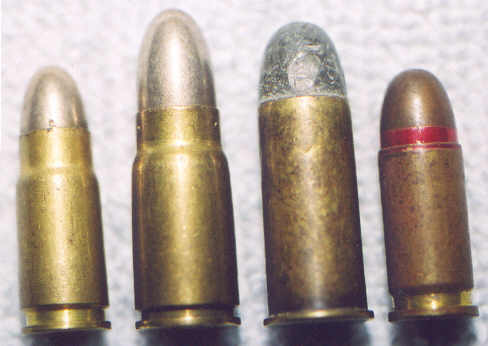
The
Japanese used three different rounds in their principal service handguns, all
of them uniquely Japanese: 8mm Nambu, 9mm revolver and 7mm Nambu. There is information
about these calibers in Cartridges of the
World, Revised 5th Edition by Frank C. Barnes, editor (DBI
Books, Northbrook, Illinois, 1985) on pages 173 (7mm Nambu) and 182 (8mm
Nambu). Oddly, the book does not include 9mm Japanese revolver, though almost
ten times as many guns were made for it as the 7mm Nambu cartridge. The
Japanese made several other foreign calibres, especially .32 ACP. These were
principally for pistols privately purchased by officers, although a few
Japanese-made guns were also chambered for rounds like .25 ACP or .32 ACP.
In
the photo above, the cartridge on the left is a 7mm Nambu for the Baby. The bottle-necked
cartridge to the right of that is an 8mm Nambu for the Type 14, Type 94, Papa,
Grandpa and a few others. Second from the right is a 9mm Japanese revolver (for
the Type 26). The one on the far right with the red band is a Japanese-made .32
ACP, mostly used in imported pistols but also in some domestic ones like the
Hamada.
8mm
Nambu
This
was the standard Japanese service round, used in the Grandpa Nambu, Papa Nambu,
Type 14 and Type 94 pistols, as well as the Type 100 submachine gun and a few
other small volume pistols. The original 8mm Nambu ammo came in 15 round boxes,
two of which would fit in the pouch on the holster. These boxes are very
scarce. I paid C$3 (US$2.16) for one original round at a gun show in Calgary in
April, 2003, and have bought others for as little as C$1 (US$.75) but I have
seen people try to sell them for as much as C$10 a round (US$7.20).
The
8mm Nambu round looks a little like 7.65mm Luger (also called .30 Luger). At
the far left are two original 8mm Nambu rounds, one with a copper jacket and
one with cupro-nickel (silver-coloured). The slightly shorter round next to it
is a W.R.A. 7.65 Luger round. The second one from the right is a little longer.
It is a 7.63 Mauser / .30 Mauser round used in the Broomhandle Mauser. At the
far right is a Yugoslav 7.62mm Tokarev, also called 7.62 TT or .30 Tokarev. It is
basically a hotter loading of the 7.63 Mauser. US and
Canadian dimes as well as a ruler are included in this shot and the other
comparisons below for scale.

Ballistically
the 8mm Nambu is very similar to the .380ACP, even though it is much bigger in
external dimensions. Both fire a bullet of around 100 grains at muzzle
velocities of around 1,000 feet per second, give or take a bit.
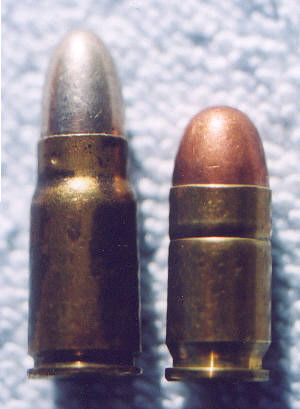
Here are seven different 8mm Nambu rounds. From
left to right: cupro-nickel bullet with small punch-crimp on neck; cupro-nickel
bullet with large punch crimp on neck; copper jacketed with large punch crimp
on neck; dummy/practice round (see below); early post-war B&E rounds from
the USA (see below); 1980s Midway round (note punch crimp); current production
OWS round (see section on gShooting Ammoh re the last two).
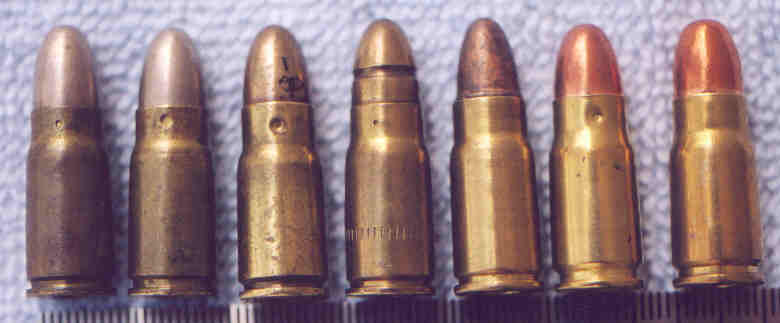
Here
are the heads of six 8mm Nambu cartridges. The two on the far left are original
Japanese rounds. Third from the left is the dummy round (note darker,
copper-coloured gprimerh). Third from the right is the B&E round, then a
post-war Midway round (now discontinued). The one on the far right is a current
manufacture round from Old Western Scrounger. They use cases from Huntington
Die Specialties, hence the gH.D.S.h on the headstamp.

The dummy round has a groove in the projectile
and knurling around the cartridge case.
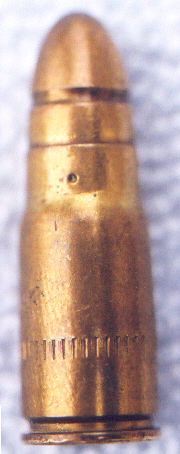
As noted above, the practice round has a darker,
reddish, copper-coloured primer (right) as opposed to the yellowish brass
coloured one on regular rounds.
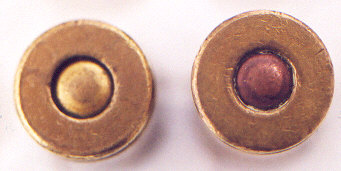
This is a late manufacture (January, 1945)
copper-jacketed round from a full box of ammo I bought.
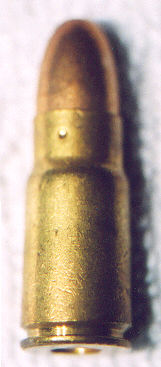
Herefs something I didnft know until Jim Brown
(co-author of the Derby & Brown book) sent me this example. The priming
compound inside the primer cup had a thin foil covering on it to protect it
during manufacturing. This primer was removed from a WWII-era Japanese 8mm
Nambu round using hydraulic pressure. It got slightly deformed in the process.
Like all such primers, it is Berdan.
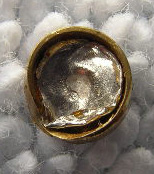
As long as we are looking at the insides of the cases, letfs go all the way. A cartridge collector friend of mine sectioned these two original Japanese 8mm Nambu rounds. The one on the left is the earlier, cupro-nickel-jacketed type, while the one on the right is the later copper or gilding-metal jacketed type. Bullet weights were 6.59 grams (=101.7 grains) for the cupro-nickel and 6.54 grams (100.9 grains) for the copper/gilding metal rounds. Powder weight of .29 grams (4.5 grains) was identical in the two rounds. Note the interesting shape of the powder grains. By the way, donft copy the load of 4.5 grains unless you have a stock of this exact WWII Japanese powder and these exact bullets and cases!
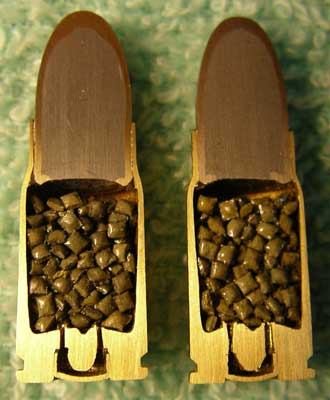
Besides
the original Japanese rounds, at least one other type qualifies as collectible.
In the early post-war period there were more war
souvenir Nambus than there was ammo, so in 1948 two enterprising residents of
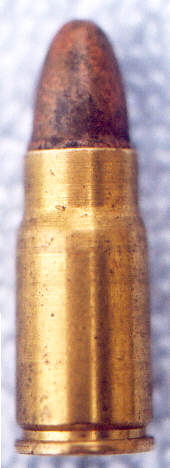
This
headstamp doesnft show up very well, but across the top it says gNAMBUh. At
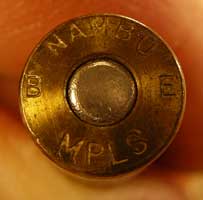
This is a 50-round B&E box from a friendfs
collection.
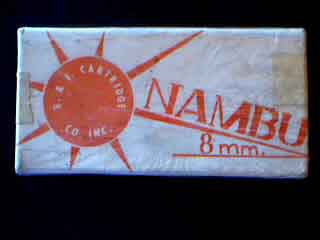
(Photo courtesy of the Dale Crabtree Collection)
This is a shot of the side of the box.
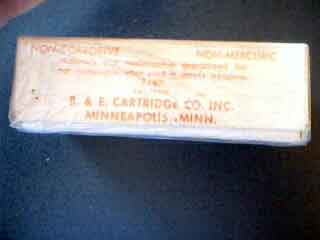
(Photo courtesy of the
Dale Crabtree Collection)
9mm
Japanese revolver:
This
round was used only in the Type 26 revolver. It is similar in size to a .38
S&W. The ballistics are like a very mild .38
S&W load. The cartridges are NOT interchangeable. The rim on the 9mm round
is much thinner and the chamber pressure is lower than most .38 S&W loads.
Here is an original 9mm Japanese revolver round next to two .38 S&W loads,
a recent commercial Remington with 145 grain bullet and an older Canadian
Dominion Armories military load with 178 grain bullet.
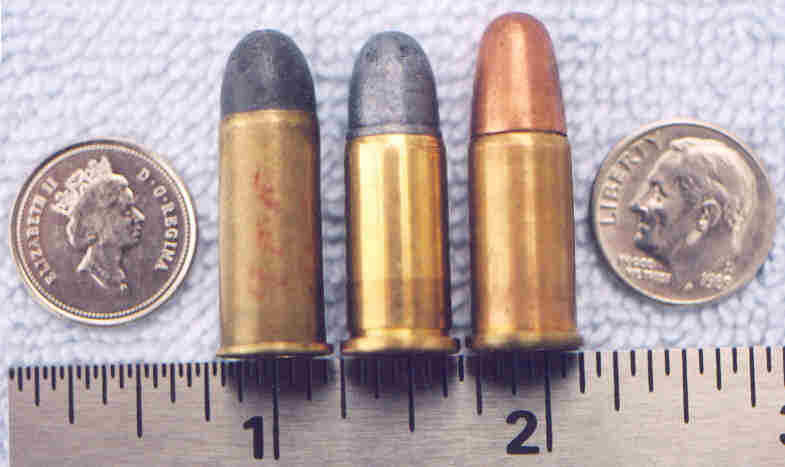
Again,
the two original rounds on the left have no headstamps, while the two on the
right are both post-war Midway ammo (now discontinued).

Here
is a 9mm round I had a friend section for me. Note that the powder looks like
the same as was used in the 8mm rouns above, and also
that there is a cardboard wad in between the bullet and powder. I had not read
about that wad being present in any of the references I had read.
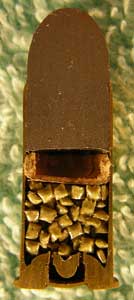
7mm
Nambu:
Here
are four slightly different variations of 7mm Nambu cartridges. The one on the
far right is Thai and has a copper-jacketed bullet. The other three are
Japanese and have cupro-nickel jackets (silver coloured). They differ mostly in
the crimping. The first one on the left has a tiny punch crimp (dead centre
near the top of the cartridge case). The next one has an overall press crimp
that leaves no visible marks on the case. The second one from the right has a
type of press crimp that leaves a tiny raised vertical line between the spots
where pressure was applied. It is also noticeably shorter.
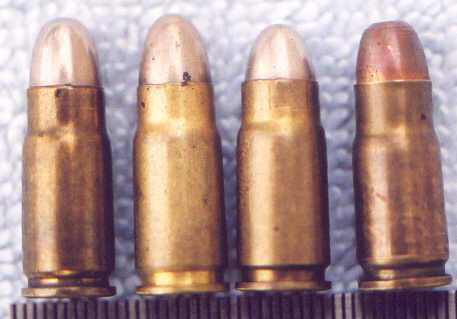
This
shot shows that the four cartridges above have no head stamps. Japanese pistol
cartridges didnft have head stamps at all; some Thai ones had weak head stamps,
but therefs no trace of them on these rounds. The Thai round on the far right
seems to have a darker line around the primer, perhaps from some kind of
sealant.

Here
is a Thai 7mm Nambu round on the far left with some others for comparison. Just
to the right of it is a Geco .32 ACP (7.65 ACP) round and a Remington .22 Long
Rifle. At the far left is an empty brass casing for .30 M-1 carbine. The two
have the same head diameter and one can make 7mm brass from the
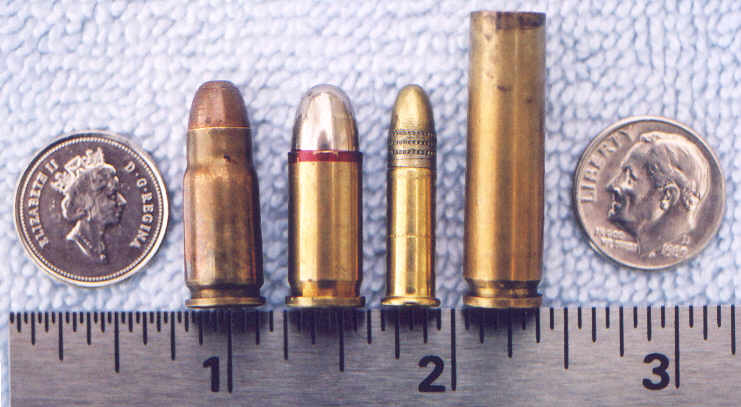
Ballistically
the 7mm Nambu (left) is comparable to the .32ACP (right). It fires a lighter
bullet at higher velocity, but their muzzle energy is about the same. It is
certainly better then the .25ACP (second from left), which is what some
officers probably would have ended up with in a small handgun (Japanese
officers carried a variety of privately purchased foreign handguns including
especially a lot of Mausers in .25ACP). A .22 Long Rifle cartridge (second from
right) is also included in this shot for comparison, but strangely it seems the
Japanese never used this, even for training.
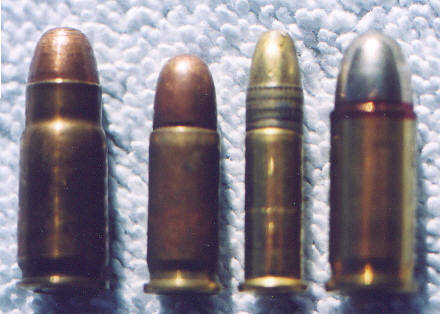
A
cartridge collector friend sectioned this 7mm Nambu round for me. It is the
gstandardh Japanese type with cupro-nickel-jacketed bullet. The bullet weight
was 3.58 grams (55.25 grains), and the powder charge weighed 0.18 grams (2.8
grains). Of course, you should not use this powder charge unless you have the
same powder the Japanese used as well as the same cases and bullets. Note that
this was a finer-grained powder than in the 8mm Nambu sectioned rounds shown
above.
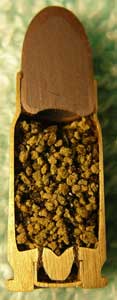
.32ACP
This was probably the most widely used gforeignh calibre and was produced by the Japanese for use in imported pistols privately purchased by officers as well in domestically made guns like the Hamada. The Japanese called .32 ACP gcartidges for medum-sized Mauser-type pistolh due to the popularity of the Model 1914/1934 Mauser pocket pistols as private purchase sidearms among officers. Here are two original Japanese .32 ACP rounds.
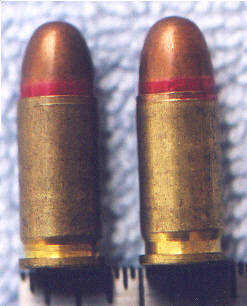
Again, no headstamps.
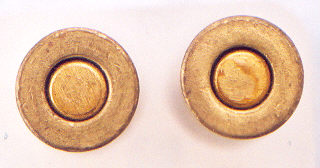
.44
Russian
The
first modern handgun adopted by the Japanese was the Smith & Wesson Model 3
revolver in .44 Russian calibre. It was the official
handgun of the Imperial Japanese Army from 1878 to 1894, and of the Imperial
Japanese Navy from 1878 to 1909. Between 1878 and 1908 approximately 16,000
Smith & Wessons were imported. Some were still in service at the end of
WWII and were brought to the
The
.44 Russian is basically a shorter version of the .44 Special, which in turn
was lengthened further and became the legendary .44 Magnum many years later.
Original Japanese .44 Russian cartridges are quite scarce. Much of the .44
ammunition left at the end of the war had already deteriorated to the point it
would not reliably fire. The collector who sold me the one I show below said he
recently discovered there are actually two variations. The most common one has
a brass case that is drawn in the normal fashion, but some appear to have been
turned based on machining marks on the cases. This one is the standard drawn
type.
Here is my Japanese .44 Russian round.
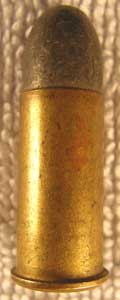
Here it is on the left with a
n American U-M-C .44 Russian round on the right for comparison.
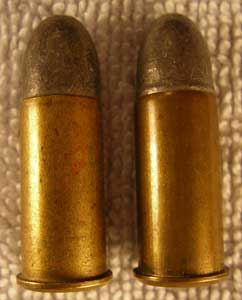
Once again, there is no headstamp.
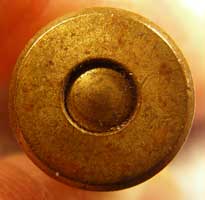
Other
Calibres:
The Japanese made ammunnition in
several other pistol calibres to supply the private purchase weapons of their
officers. Among these were .25 ACP, 7.65 Luger, 7.63 Mauser, .380ACP and 9mm
Parabellum. However, these rounds are even rarer than the .32ACP and .44
Russian shown above.
Books:
Almost
all the reference books on Japanese handguns cover the ammunition, with the new
Derby & Brown book probably having the best coverage. Books on ammunition
are somewhat less helpful, offering little coverage of the handgun cartridges.
In
July, 2003 I received a copy of Japanese
Ammunition, 1880 to 1945 by John Elks (1981: publisher and place of
publication unknown). Unfortunately it has very little information on handgun
cartridges (pp. 7-9; most of it is about rifle and heavy machine gun ammo up to
40mm). The text also has several errors with respect to the handguns
themselves, although in fairness this may have been the state of knowledge at
the time the manual was produced over 20 years ago.
In
March, 2004 I obtained a reprint of a March, 1953 US Army Technical Manual TM
9-1985-5, Japanese Explosive Ordnance
(Army Ammunition, Navy Ammunition). It makes only brief references to the
8mm and 9mm handgun cartridges on pages 277-278.
Click here to go back
to the Ammunition & Reloading page: Nambu World Ammunition & Reloading
Page
Click here to go back
to the main page: Nambu World: Terifs WWII Japanese
Handgun Website